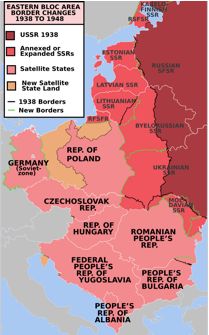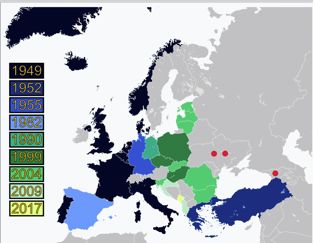What Motivates Vladimir Putin?

The Marshall Plan was an American investment in the economy and infrastructure of the war-torn continent of Europe after WWII. Vladimir Putin was born four years after the Marshall Plan ended into the world it created.
The goal of this plan was to spread democracy, mutual trust, and trade between countries in Europe. Germany, who held most of Europe’s industrial capabilities even after World War II had ended, was a particular focus.
Just as much however, it was a necessary counter to Soviet aggression in the region. Without US engagement in Western Europe after World War II, the Soviet Union would be left to rebuild the continent in its image. This would have meant a European continent fully subservient to Communist forces in Moscow. It surely would have provided the USSR with the strength not only to prevent its future dissolution, but also to challenge the USA directly.
As such, investment in Western Europe after World War II was seen not so much as a humanitarian effort, but as a matter of national security. Without it, the Cold War would surely have turned hot.
Today, the Western world is inundated with a barrage of stories concerning the atrocities of Russian government, its proxies, and its (very few) allies. Unfortunately, the Western world has been slow to realize the cause of these provocations. The delayed dawning has hampered our ability to effectively deal with them. The reason we have been unable to grasp Russian intent is due in part to the way we learn history.
History... Not Much of a Guide in American Schools
Our history lessons are put into an arbitrary vacuum, limiting our ability to fully grasp the cause and effect relationships that define the global course of events.
For example, can you explain the direct cause and effect relationship between World War II and the Cold War? Most cannot. In fact, most are unaware that such a relationship exists. Most people think the two conflicts are unrelated when they are actually attached at the hip.
This is because in school, we are taught about WWII, and we are taught about the Cold War. We are not taught that the diplomatic standoff that ensued after World War II as the United States and Russia competed over the future of Europe, leading directly to the Cold War.
We are not taught that NATO, a mutual defense agreement between the US and Western Europe, only came about out of sheer necessity. The Soviet Union forced the creation of NATO by using military force to to install a Communist government in Czechoslovakia (now known as the Czech Republic and Slovakia) during the Marshall Plan years.
Our understanding of history is often limited to “in this year, this happened” instead of examining cause and effect relationships of world shaping events. We look at the actions of the Russian government and can find no logical explanation for it, even though the answer stares us in the face.
Understanding Russia's Motivations
Russia’s western border is a vast plain, with no mountain ranges or bodies of water obstructing a potential enemy from invading it. In fact, from the years 1812 to 1941, Russia was invaded four separate times. This fostered a deep feeling of insecurity amongst the Soviet government and its people. So, when Western Europe was ravaged by the effects of World War II, Russia sought to use this moment of comparative advantage to secure its borders by installing pro-Russian governments in its neighboring states.

In the picture above we can see how, in the wake of World War II, the Soviet government extended their reach as far west as East Germany.
The expansion of Soviet influence into Germany was significant for three reasons. First, Eastern Germany housed much of Germany’s remaining industrial capacity, providing the Soviet Union with a means to rebuild their own country in the short term, and export goods in the long term.
The second reason this was significant is because it further expanded the Soviet “Buffer zone”, which served to protect the Soviet heartland.
The final, and significant reason, is because Germany had just invaded Russia in the World War II. Keeping Germany divided into two states, with the more powerful state (as well as the German capital of Berlin) being held under Soviet control, ensured that the heartland of Russia could never again be invaded.
As such, the Soviet government did everything in its power to ensure that the spread of democracy stopped at West Germany. This includes the aforementioned military coup in Czechoslovakia, preventing a government not loyal to Moscow to form in the Soviet sphere.
Prior to this coup, the United States was immensely reluctant to pledge any military support to Europe on top of it’s sizable economic support. However, the Soviet coup of Czechoslovakia was a harbinger. If the United States did not guarantee military support to western European countries, then Russia would continue engage in such activities whenever they felt threatened.
As a result, the North Atlantic Treaty Organization was formed shortly after the end of WWII. This treaty was originally meant to keep the Soviets from attempting to expand their influence past East Germany, but after the Soviet Union collapsed in 1991, a large power vacuum from East Germany to the western border of Russia was formed, and NATO began to fill that vacuum.
The Problem with NATO Expansion
The Soviet Union, and now Russia, seeks to make up for the lack of geographic barriers to invasion by creating buffer states. When the Soviet Union fell, and NATO began expanding to the east, devouring Russia’s former buffer states, a feeling of deep insecurity once again took hold in Russia.
This happened at a critical time in Russia’s history. After the fall of the USSR and before Vladimir Putin came to power, the Russian people had an appetite to democratize. However, pro-democracy advocates in Russia were vying for closer ties with the West at the same time the West was putting military bases closer and closer to the borders of Russia. This had the effect of undermining the credibility of the Russian democrats. Those in favor of a nationalist, authoritarian government exploited the fears of their people by contending that Russia must do everything in its power to counter the West’s NATO expansion, or risk being invaded again.
Today, we are experiencing the adverse effects of the irresponsible expansion of NATO. This expansion gave Vladimir Putin the little political cover he needed to kill Russian democracy in its infancy. It also allowed him to portray the West as an enemy of Russia, regardless of whether or not that is/was actually true.

The Real Reason Russia Invaded Georgia and Ukraine
Once again, our “history in a vacuum” issue has precluded us from truly grasping why Russia invaded Georgia (denoted by the one red dot) and Ukraine (two red dots). These were not random land grabs by Vladimir Putin, instead, they were strategic decisions designed to preserve Russia’s ever shrinking “Western buffer”.
We can begin with Georgia, the southern neighbor to Russia that was invaded in 2008. Prior to the invasion, Georgia had expressed a desire to join NATO, and had actually begun assisting the US military in Middle Eastern affairs. Georgia’s entrance into NATO would have put US military personnel directly on Russia’s border. As a response, Putin made a move that would prevent Georgia from being able to join NATO - initiating a border dispute.
A membership prerequisite for NATO is the resolution of all border disputes. Since Georgia was now partially occupied, they were automatically disqualified from gaining entry into NATO. The rationale behind the 2014 invasion of Ukraine is identical to the rationale for invading Georgia.
Putting Russian Provocations into Context
Now that we fully understand what motivates Russia, it should become exceedingly clear why Russia seeks to break up the EU and NATO while also causing discord in the United States.
In the recent past, Western leaders have made the grave error of attempting to calm Russia through appeasement. Although Russia’s insecurity should now be easy to understand, that does not justify invading sovereign nations like Ukraine and Georgia, or meddling in the affairs of Europe and the US. As such, a practical approach like the one taken in the days of World War II is once again needed. This means understanding the difference between provoking and defending.
For example, the sanctions enacted after the invasion of Ukraine are an example of defending, while the rapid expansion of NATO in the late 1990s and early 200s is an example of provoking. The United States and its allies must make clear that the only punitive actions taken against Russia are ones taken for the reason of defense.
However, it would be neither responsible nor sustainable to answer the Russian question by shrinking NATO. Although it was perhaps a strategic mistake to bring Eastern European states like Latvia and Estonia into NATO when existing members already lacked the desire and resources needed to actually defend them, abandoning them to Russian subterfuge would only show Russia that if they cause enough discomfort to the West, they can take whatever they want. This is a precedent that must be avoided at all cost.
The Russian Power Structure: Vladimir Putin
In order to effectively answer the Russian Question, we need to understand the power structure of Russian society. In the United States power is quite decentralized when one considers the three branches of government and a private sector that can usually operate independently. Russia’s power is completely consolidated under Vladimir Putin. In other words, one cannot become rich and powerful in Russia without being in the good graces of Vladimir Putin.
In return for loyalty and performing some of the Russian government’s dirty deeds (like running troll farms to disperse propaganda in the West), these individuals are rewarded with top government and quasi-private sector positions, enabling them to accumulate massive amounts of wealth.
This wealth allows these individuals, known as oligarchs, to enjoy a lifestyle generally not afforded to Russian citizens. Specifically, these oligarchs house much of their wealth in Western financial institutions. Many of them own massive physical assets such as estates or even sports teams in Europe. For example, Roman Abramovich owned Chelsea FC for eight years, and Dmitry Rybolovlev has been the President of AC Milan for eight years.
Individuals like the two above depend on Putin to keep their Western assets safe. As such, the most effective means that the West can take to counter Putin’s aggression is to drive a wedge between him and his oligarchs. In order to accomplish this, the West must respond to Putin's provocations by seizing the assets of Russian oligarchs. If Putin cannot protect their wealth, they will be less willing to help him with his dirty work.
History Does not Repeat; History Instructs
If we make the effort to put current events into a historical context, we can better navigate the road ahead. While world affairs is an immensely complicated and opaque space, we can better understand why people do things if we make an effort to understand their past. Russian provocations today are a reaction to Western policies since the end of World War II rather than something occurring spontaneously.
While history does not truly repeat, it does instruct, and understanding our history provides us with the most effective manual we can hope for in dealing with the challenges of the 21st century.



